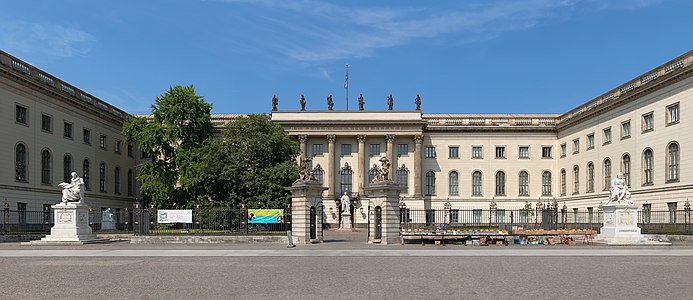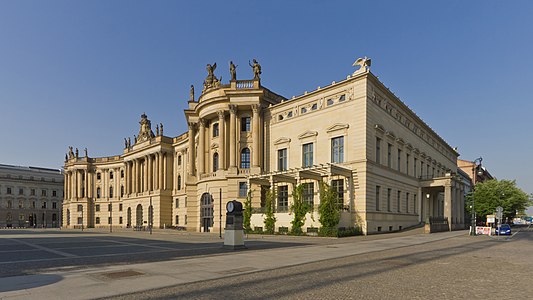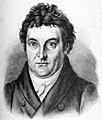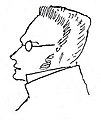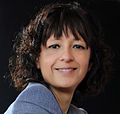Humboldt University of Berlin
Humboldt-Universität zu Berlin | |
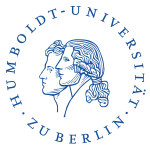 | |
| Motto | Universitas litterarum(Latin) |
|---|---|
Motto in English | The Entity of Sciences |
| Type | Public |
| Established | 15 October 1810[1] |
| Budget | €536.0 million (2022)[2] |
| President | Julia von Blumenthal |
Academic staff | 2,403[3] |
Administrative staff | 1,516[3] |
| Students | 32,553[3] |
| Undergraduates | 18,712[4] |
| Postgraduates | 10,881[4] |
| 2,951[4] | |
| Location | , Germany 52°31′05″N13°23′36″E/ 52.51806°N 13.39333°E |
| Campus | Urban and suburban |
| Nobel Laureates | 57 (as of 2020)[5] |
| Colors | Blue and White[6] |
| Affiliations | |
| Website | hu-berlin.de |
TheHumboldt University of Berlin(German:Humboldt-Universität zu Berlin,abbreviatedHU Berlin) is apublicresearch universityin the central borough ofMitteinBerlin,Germany.
The university was established byFrederick William IIIon the initiative ofWilhelm von Humboldt,Johann Gottlieb FichteandFriedrich Daniel Ernst Schleiermacheras theUniversity of Berlin(Universität zu Berlin) in 1809, and opened in 1810,[7]making it the oldest of Berlin's four universities.[contradictory]From 1828 until its closure in 1945, it was namedFriedrich Wilhelm University(German:Friedrich-Wilhelms-Universität).[8][9]During theCold War,the university found itself inEast Berlinand wasde factosplit in two when theFree University of Berlinopened inWest Berlin.The university received its current name in honour ofAlexanderandWilhelm von Humboldtin 1949.[10]
The university is divided into nine faculties including itsmedical schoolshared with the Freie Universität Berlin. The university has a student enrollment of around 32,000 students, and offers degree programs in some 189 disciplines from undergraduate to post-doctorate level.[11]Its main campus is located on theUnter den Lindenboulevard in central Berlin. The university is known worldwide for pioneering theHumboldtian model of higher education,which has strongly influenced other European and Western universities.[12]
It was generally regarded as the world's preeminent university for thenatural sciencesduring the 19th and early 20th century, as the university is linked to major breakthroughs in physics and other sciences by its professors, such asAlbert Einstein.[13]Past and present faculty and notable alumni include 57 Nobel Prize laureates[5](the most of any German university), as well as scholars and academics includingAlbert Einstein,Hermann von Helmholtz,Emil du Bois-Reymond,Robert Koch,Theodor Mommsen,Karl Marx,Friedrich Engels,Otto von Bismarck,W. E. B. Du Bois,Arthur Schopenhauer,Georg Wilhelm Friedrich Hegel,Walter Benjamin,Max Weber,Georg Simmel,Karl Liebknecht,Ernst Cassirer,Heinrich Heine,Eduard Fraenkel,Max Planck,Wernher von Braunand theBrothers Grimm.
History[edit]
Main building[edit]
The main building of Humboldt-Universität is the Prinz-Heinrich-Palais (English:Prince Henry's Palace) onUnter den Lindenboulevard in thehistoric centreofBerlin.It was erected from 1748 to 1753 forPrince Henry of Prussia,the brother ofFrederick the Great,according to plans byJohann BoumanninBaroque style.In 1809, the former Royal Prussian residence was converted into a university building. Damaged during theAllied bombing in World War II,it was rebuilt from 1949 to 1962.[14]
In 1967, eight statues from the destroyedPotsdam City Palacewere placed on the side wings of the university building. Currently there is discussion about returning the statues to the Potsdam City Palace, which was rebuilt as theLandtag of Brandenburgin 2013.[15]
Early history[edit]
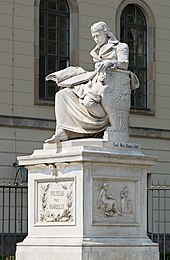
The University of Berlin was established on 16 August 1809, on the initiative of the liberal Prussian educational politicianWilhelm von HumboldtbyKing Friedrich Wilhelm III,similar toUniversity of Bonn,during the period of thePrussian Reform Movement.The university was located in a palace constructed from 1748 to 1766[16]for the latePrince Henry,the younger brother ofFrederick the Great.[17]After his widow and her ninety-member staff moved out, the first unofficial lectures were given in the building in the winter of 1809.[17]Humboldt faced great resistance to his ideas as he set up the university. He submitted his resignation to the King in April 1810, and was not present when the school opened that fall.[1]The first students were admitted on 6 October 1810, and the first semester started on 10 October 1810, with 256 students and 52 lecturers[10]in faculties of law, medicine, theology and philosophy under rector Theodor Schmalz. The university celebrates 15 October 1810 as the date of its opening.[1]In 1810, at the time of the opening, the university established the firstacademic chairin the field of history in the world.[18]From 1828 to 1945, the school was named the Friedrich Wilhelm University, in honor of its founder.Ludwig Feuerbach,then one of the students, made a comment on the university in 1826: "There is no question here of drinking, duelling and pleasant communal outings; in no other university can you find such a passion for work, such an interest for things that are not petty student intrigues, such an inclination for the sciences, such calm and such silence. Compared to this temple of work, the other universities appear like public houses."[19]
The university has been home to many of Germany's greatest thinkers of the past two centuries, among them the subjective idealist philosopherJohann Gottlieb Fichte,the theologianFriedrich Schleiermacher,the absolute idealist philosopherG.W.F. Hegel,the Romantic legal theoristFriedrich Carl von Savigny,the anti-optimist philosopherArthur Schopenhauer,the objective idealist philosopherFriedrich Schelling,cultural criticWalter Benjamin,and famous physicistsAlbert EinsteinandMax Planck.
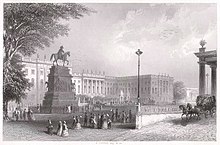
The founders of Marxist theoryKarl MarxandFriedrich Engelsattended the university, as did poetHeinrich Heine,novelistAlfred Döblin,founder ofstructuralismFerdinand de Saussure,German unifierOtto von Bismarck,Communist Party of GermanyfounderKarl Liebknecht,African AmericanPan AfricanistW. E. B. Du Boisand European unifierRobert Schuman,as well as the influential surgeonJohann Friedrich Dieffenbachin the early half of the 1800s.
The structure of German research-intensive universities served as a model for institutions likeJohns Hopkins University.Further, it has been claimed that "the 'Humboldtian' university became a model for the rest of Europe [...] with its central principle being the union of teaching and research in the work of the individual scholar or scientist."[20]
Enlargement[edit]

In addition to the strong anchoring of traditional subjects, such as science, law, philosophy, history, theology and medicine, the university developed to encompass numerous new scientific disciplines.Alexander von Humboldt,brother of the founder William, promoted the new learning. The construction of modern research facilities in the second half of the 19th century aided the teaching of the natural sciences. Famous researchers, such as the chemistAugust Wilhelm Hofmann,the physicistHermann von Helmholtz,the mathematiciansErnst Eduard Kummer,Leopold Kronecker,Karl Weierstrass,the physiciansJohannes Peter Müller,Emil du Bois-Reymond,Albrecht von Graefe,Rudolf Virchow,andRobert Koch,contributed to Berlin University's scientific fame.
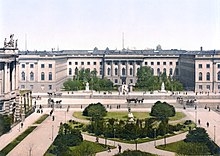
During this period of enlargement, the university gradually expanded to incorporate other previously separate colleges in Berlin. An example would be theCharité,the Pépinière and the Collegium Medico-chirurgicum. In 1710, KingFriedrich Ihad built aquarantinehouse forPlagueat the city gates, which in 1727 was rechristened by the "soldier king"Friedrich Wilhelm:"Es soll das Haus die Charité heißen" (It will be called Charité [French forcharity]). By 1829 the site became the Friedrich Wilhelm University's medical campus and remained so until 1927 when the more modern University Hospital was constructed.
The university started anatural historycollection in 1810, which by 1889, required a separate building and became theMuseum für Naturkunde.The preexisting Tierarznei School, founded in 1790 and absorbed by the university, in 1934 formed the basis of the Veterinary Medicine Facility (Grundstock der Veterinärmedizinischen Fakultät). Also theLandwirtschaftliche Hochschule Berlin(Agricultural University of Berlin), founded in 1881 was affiliated with the Agricultural Faculties of the university.
In August 1870, in a speech delivered on the eve of war with France,Emil du Bois-Reymondproclaimed that "the University of Berlin, quartered opposite the King's palace, is, by the deed of our foundation, the intellectual bodyguard of theHouse of Hohenzollern(das geistige Leibregiment des Hauses Hohenzollern). "[22]
Third Reich[edit]
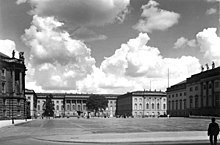
After 1933, like all German universities, Friedrich Wilhelm University was affected by theNazi regime.The rector during this period wasEugen Fischer.It was from the university's library that some 20,000 books by "degenerates"andopponents of the regimeweretaken to be burnedon 10 May of that year in the Opernplatz (now theBebelplatz) for a demonstration protected by theSAthat also featured a speech byJoseph Goebbels.A monument to this can now be found in the center of the square, consisting of a glass panel opening onto an underground white room with empty shelf space for 20,000 volumes and a plaque, bearing an epigraph from an 1820 work byHeinrich Heine:"Das war ein Vorspiel nur, dort wo man Bücher verbrennt, verbrennt man am Ende auch Menschen" ( "This was but a prelude; where they burn books, they ultimately burn people" ).
TheLaw for the Restoration of the Professional Civil Service(German "Gesetz zur Wiederherstellung des Berufsbeamtentums" ) resulted in 250 Jewish professors and employees being fired from Friedrich Wilhelm University during 1933–1934 and numerous doctorates being withdrawn. Students and scholars and political opponents of Nazis were ejected from the university and often deported. During this time nearly one third of all of the staff were fired by the Nazis.
Cold War[edit]
This articleneeds additional citations forverification.(August 2017) |
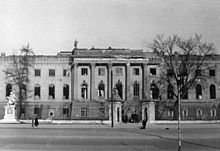

During theCold War,the university was located inEast Berlin.It reopened in 1946 as the University of Berlin, but faced repression from theSoviet Military Administration in Germany,including the persecution of liberal and social democrat students. Almost immediately, the Soviet occupiers started persecuting non-communists and suppressing academic freedom at the university, requiring lectures to be submitted for approval bySocialist Unity Partyofficials, and piped Soviet propaganda into the cafeteria. This led to strong protests within the student body and faculty.NKVDsecret policearrested a number of students in March 1947 as a response. The Soviet Military Tribunal inBerlin-Lichtenbergruled the students were involved in the formation of a "resistance movement at the University of Berlin", as well as espionage, and were sentenced to 25 years of forced labor. From 1945 to 1948, 18 other students and teachers were arrested or abducted, many gone for weeks, and some taken to theSoviet Unionand executed. Many of the students targeted by Soviet persecution were active in the liberal or social democratic resistance against the Soviet-imposed communist dictatorship; the German communist party had regarded the social democrats as their main enemies since the early days of the Weimar Republic.[23]During theBerlin Blockade,theFreie Universität Berlinwas established as a de facto western successor inWest Berlinin 1948, with support from the United States, and retaining traditions and faculty members of the old Friedrich Wilhelm University. The name of the Free University refers to West Berlin's perceived status as part of the Western "free world",in contrast to the" unfree "Communist world in general and the" unfree "communist-controlled university inEast Berlinin particular.[23]
Since the historical name, Friedrich Wilhelm University, had monarchic origins, the school was officially renamed in 1949. Although the Soviet occupational authorities preferred to name the school after a communist leader, university leaders were able to name it the Humboldt-Universität zu Berlin, after the two Humboldt brothers, a name that was also uncontroversial in the west and capitalized on the fame of the Humboldt name, which is associated with theHumboldtian model of higher education.[24]
Modern Germany[edit]

After theGerman reunification,the university was radically restructured under the Structure and Appointment Commissions, which were presided by West German professors.[25][26]For departments on social sciences and humanities, the faculty was subjected to a "liquidation" process, in which contracts of employees were terminated and positions were made open to new academics, mainly West Germans. Older professors were offered early retirement.[26][27]The East German higher education system included a much larger number of permanent assistant professors, lecturers and other middle level academic positions. After reunification, these positions were abolished or converted to temporary posts for consistency with the West German system.[28]As a result, only 10% of the mid-level academics in Humboldt-Universität still had a position in 1998.[26]Through the transformations, the university's research and exchange links with Eastern European institutions were maintained and stabilized.[25]
Today, Humboldt University is a state university with a large number of students (36,986 in 2014, among them more than 4,662 foreign students) after the model of West German universities, and like its counterpart theFreie Universität Berlin.
The university consists of three different campuses, namely Campus Mitte, Campus Nord and Campus Adlershof. Its main building is located in the centre of Berlin at the boulevardUnter den Lindenand is the heart of Campus Mitte. The building was erected on order by KingFrederick IIfor his younger brotherPrince Henry of Prussia.All the institutes of humanities are located around the main building together with the Department of Law and the Department of Business and Economics. Campus Nord is located north of the main building close toBerlin Hauptbahnhofand is the home of the life science departments including the university medical centerCharité.The natural sciences, together with computer science and mathematics, are located at Campus Adlershof in the south-east of Berlin. Furthermore, the university continues its tradition of a book sale at the university gates facing Bebelplatz.
Organization[edit]
Faculties and departments[edit]
The university is divided ino 9 faculties[29]:
| Faculty | Departments |
|---|---|
| Faculty of Arts and Humanities |
|
| Faculty of Economics and Business Administration | |
| Faculty of Humanities and Social Sciences |
|
| Faculty of Law | |
| Faculty of Language, Literature and Humanities |
|
| Faculty of Life Sciences |
|
| Faculty of Mathematics and Natural Sciences |
|
| Faculty of Theology | |
| Charité - Universitätsmedizin Berlin |
Graduate schools[edit]
Graduate schools provide structured PhD programmes[35]:
- Berlin Graduate School of Ancient Studies
- Berlin Graduate School of Social Sciences
- Berlin-Brandenburg School for Regenerative Therapies
- Berlin School of Mind and Brain
- Berlin Mathematical School
- Graduate School of Ancient Philosophy
- Humboldt Graduate School
- SALSA - School of Analytical Sciences Adlershof
- Graduate School "Advanced Materials"
Central institutes[edit]
Furthermore, there are four central institutes (Zentralinstitute) that are part of the university:
- Centre for British Studies(in German:Großbritannienzentrum)
- Humboldt-Innovation (research transfer and spin-off service)
- Museum für Naturkunde(Natural History Museum)
- Späth-Arboretum
Student parliament[edit]
Each year, students elect the student parliament (Studierendenparlament), which serves as the body ofstudent representatives under German law(AStA).[36]
| List | 2022[37][38] | 2023[39][40] | 2024[41] | |
|---|---|---|---|---|
| Linke Liste an der HU | 8 | 14 | 19 | |
| Grünboldt | 6 | 5 | 8 | |
| Juso-Hochschulgruppe | 13 | 7 | 6 | |
| OLKS – Offene Liste Kritischer Studierender | 9 | 6 | 6 | |
| International Youth and Students for Social Equality | 3 | 2 | 5 | |
| Queer-feministische LGBT*I*Q*-Liste | 6 | - | 5 | |
| Liberale Hochschulgruppe | - | 3 | 4 | |
| RCDS –Association of Christian Democratic Students | 8 | 2 | 3 | |
| Die Pendler:innen – Wir fahren ein! | - | - | 2 | |
| ZfgU – Zeit für gute Uni | - | 2 | 1 | |
| ewig und 3 Tage – Langzeitprojekte | - | 1 | 1 | |
| V.O.D.K.A. | - | 10 | - | |
| Die Linke.SDS HU Berlin | 4 | 4 | - | |
| Studis für Adlershof | - | 2 | - | |
| João & the autonom alkis. DIE LISTE | 3 | 2 | - | |
| Sum | 60 | 60 | 60 |
Library[edit]
When the Royal Library proved insufficient, a new library was founded in 1831, first located in several temporary sites. In 1871–1874 a library building was constructed, following the design of architect Paul Emanuel Spieker. In 1910 the collection was relocated to the building of theBerlin State Library.
During theWeimar Periodthe library contained 831,934 volumes (1930) and was thus one of the leading university libraries in Germany at that time.
During theNazi book burningsin 1933, no volumes from the university library were destroyed. The loss throughWorld War IIwas comparatively small. In 2003, natural science-related books were outhoused to the newly founded library at theAdlershofcampus, which is dedicated solely to the natural sciences.
Since the premises of the State Library had to be cleared in 2005, a new library building was erected close to the main building in the center of Berlin. The "Jacob und Wilhelm Grimm-Zentrum" (Jacob and Wilhelm Grimm Centre, Grimm Zentrum, or GZ as referred to by students) opened in 2009.
In total, the university library contains about 6.5 million volumes and 9,000 held magazines and journals, and is one of the biggest university libraries in Germany.
The books of theInstitut für Sexualwissenschaftwere destroyed during the Nazi book burnings, and the institute destroyed. Under the terms of the Magnus Hirschfeld Foundation, the government had agreed to continue the work of the institute at the university after its founder's death. However, these terms were ignored. In 2001, the university acquired the Archive for Sexology from the Robert Koch Institute, which was founded with a large private library donated byErwin J. Haeberle.This has now been housed at the new Magnus Hirschfeld Center.[42]
Academics[edit]
| University rankings | |||||||
|---|---|---|---|---|---|---|---|
| Overall – Global & National | |||||||
| |||||||
Rankings[edit]
According to the 2024QS World University Rankings,the university ranked 120th globally and 7th at the national level.[43]Additionally, in theTimes Higher Education World University Rankingsfor 2024, it was placed at 87th worldwide and 4th within the country.[44]Because of an unresolved dispute over the counting ofNobellaureates before the Second World War – both Humboldt University and theFree University of Berlinclaim to be the rightful successor of the Friedrich Wilhelm University – both do not appear in theAcademic Ranking of World Universities(ARWU) anymore since 2008.[45]
In the 2023 QS Subject Ranking, Humboldt University ranks first in Germany in the arts and humanities and the social sciences.[46]In the 2024 THE Subject Ranking, Humboldt University ranks second in Germany in the arts and humanities, law, psychology, and social sciences.[47]In the 2023 ARWU Subject Ranking, Humboldt University ranks first in Germany in geography.[48]
|
| |||||||||||||||||||||||||||||||||||||||||||||||||||||||||||||||||||||||||||||||||||||||||||||||||||||||||||||||||||||||||||||||||||||||||||||||||||||||||||||||||||||||||||||||||||||||||||||||||||||||||||||||||||||||||||||||||||||||||||||||||||||||||||||||
Measured by the number of top managers in the German economy, Humboldt-Universität ranked 53rd in 2019.[49]In 2020, the AmericanU.S. News & World Reportlisted Humboldt-Universität as the 82nd best in the world, climbing eight positions, being among the 100 best in the world in 17 areas out of 29 ranked.[50]
International partnerships[edit]
HU students can study abroad for a semester or a year at partner institutions such as theUniversity of Warwick,Princeton University,and theUniversity of Vienna.
Notable alumni and faculty[edit]
-
Albert Einstein,theoretical physicist known for developing thetheory of relativityand recipient of theNobel Prize in Physics
-
Erwin Schrödinger,physicist who developed a number of fundamental results inquantum theory,recipient of theNobel Prize in Physics
-
Max Planck,theoretical physicist and originator ofquantum theory,recipient of theNobel Prize in Physics
-
Max von Laue,physicist and recipient of theNobel Prize in Physics
-
Paul Ehrlich,physician known for curingsyphilisand recipient of theNobel Prize in Physiology or Medicine
-
Albrecht Kossel,biochemist who pioneered in the study of genetics and recipient of theNobel Prize for Physiology or Medicine
-
Jacobus Henricus van 't Hoff,pioneering chemist and the first winner of theNobel Prize in Chemistry
-
Otto Hahn,chemist, pioneer in the fields ofradioactivityandradiochemistry,and recipient of theNobel Prize for Chemistry
-
Rudolf Virchow,physician anthropologist, pathologist, prehistorian, biologist, father of modernpathology
-
Theodor Mommsen,classical scholar and recipient of theNobel Prize in Literature
-
Alfred Wegener,polar researcher and geophysicist who originated thecontinental drifthypothesis
-
Werner Heisenberg,theoretical physicist and pioneer ofquantum mechanics
-
Karl Weierstrass,mathematician, considered "the father of modernanalysis"
-
Jakob and Wilhelm Grimm,best-known collectors of German and European folk tales
-
Heinrich Heine,poet best known for his earlylyric poetry
-
Yeshayahu Leibowitz,public intellectual, scientist, and writer
-
Karl Marx,philosopher, political theorist, and socialist revolutionary
-
Friedrich Engels,philosopher and revolutionarysocialist
-
Angela Davis,political activist, philosopher
-
Georg Wilhelm Friedrich Hegel,idealist philosopher and one of the fundamental figures of modern Western philosophy
-
Johann Gottlieb Fichte,philosopher,German idealist
-
Walter Benjamin,philosopher, cultural critic and essayist
-
Ernst Cassirer,idealist philosopher
-
Arthur Schopenhauer,philosopher
-
Leopold von Ranke,historian, founder of modern source-based history
-
Barthold Georg Niebuhr,historian, statesman, banker, father of modern scholarlyhistoriography
-
Felix Mendelssohn,composer during the early Romantic period
-
Georg Simmel,sociologist and philosopher
-
W.E.B. Du Bois,civil rights activist and academic
-
Karl Liebknecht,socialist politician and revolutionary
-
Gustav Stresemann,statesman during the Weimar Republic and recipient of theNobel Peace Prize
-
Austen Chamberlain,statesman and recipient of theNobel Peace Prize
-
Gregor Gysi,politician, former President of theParty of the European Left,leader of theLeft Party (Germany)
-
Dietrich Bonhoeffer,theologian, pastor, anti-Nazi dissident, founder of theConfessing Church
-
Friedrich Schleiermacher,theologian, philosopher, biblical scholar, considered the "Father of ModernProtestant theology"
-
Emmanuelle Charpentier,professor and recipient of theNobel Prize in Chemistry
- Monika Lüke,international law scholar and former secretary general Amnesty International, Germany
See also[edit]
References[edit]
- ^abcLangner, Stefanie."Man beruft eben tüchtige Männer und läßt die Universität sich allmählich encadrieren — Humboldt-Universität zu Berlin".hu-berlin.de.[permanent dead link]
- ^"Leistungsbericht über das Jahr 2022"(PDF)(in German). Senate Chancellery of Berlin. p. 1.Retrieved8 April2024.
- ^abc"Facts and Figures".Humboldt University of Berlin.Archivedfrom the original on 16 July 2020.Retrieved15 June2017.
- ^abc"Humboldt-Universität zu Berlin".Archived fromthe originalon 3 December 2013.Retrieved2 December2013.
- ^abList of Nobel laureates by university affiliation
- ^design."Hausfarben der Humboldt-Universität".Humboldt-Universität zu Berlin(in German).Archivedfrom the original on 7 October 2022.Retrieved7 October2022.
- ^"Das moderne Original der Reformuniversität"(in German). Humboldt-Universität zu Berlin.Archivedfrom the original on 4 July 2022.Retrieved15 January2018.
- ^"Humboldt University of Berlin – university, Berlin, Germany".Encyclopedia Britannica.Archivedfrom the original on 11 May 2018.Retrieved11 May2018.
- ^During that period, it was also unofficially calledUniversität unter den Lindenafter its location in the former palace ofPrince Henry of Prussiawhich his brother, KingFrederick II,had built for him between 1748 and 1753 on the avenueUnter den Linden.
- ^ab"Berlin's oldest university faces new challenges as it turns 200".Deutsche Welle.15 October 2010.Archivedfrom the original on 4 June 2019.Retrieved4 June2019.
- ^hu_adm."Daten und Zahlen zur Humboldt-Universität — Humboldt-Universität zu Berlin".hu-berlin.de(in German).Archivedfrom the original on 23 November 2016.Retrieved11 January2018.
- ^Connell Helen,University Research Management Meeting the Institutional Challenge: Meeting the Institutional Challenge,p. 137, OECD, 2005,ISBN9789264017450
- ^Hans C. Ohanian,Einstein's Mistakes: The Human Failings of Genius,p. 156, W. W. Norton & Company, 2009,ISBN9780393070422
- ^Humboldt-UniversitätArchived1 August 2020 at theWayback Machine(in German) Landesdenkmalamt Berlin
- ^"Die Attikaskulpturen".Humboldt-Universität zu Berlin(in German). 2017.Archivedfrom the original on 5 February 2023.Retrieved11 February2023.
- ^temp_adm."Short History — Humboldt-Universität zu Berlin".hu-berlin.de.Archivedfrom the original on 10 October 2022.Retrieved11 May2018.
- ^abNolte, Dorothee (12 October 2009)."200 Jahre Humboldt-Uni: Der Ort: Ein Palais Unter den Linden".Die Zeit.Archivedfrom the original on 11 May 2018.Retrieved11 May2018.
- ^Benedict Anderson(1991).Imagined Communities.New York City & London:Verso Books.p. 194.ISBN0-86091-329-5.
- ^Mclellan, David (1981).Karl Marx: A Biography(Fourth ed.). Palgrave Macmillan. p.15.
- ^Anderson, Robert (March 2010)."The 'Idea of a University' today".History & Policy.United Kingdom. Archived fromthe originalon 31 March 2014.Retrieved9 December2010.
- ^Rüegg 2004, pp. 4–6
- ^Hayek, Friedrich A. (13 September 2010)."Planning, Science, and Freedom".Mises Institute.Archivedfrom the original on 25 February 2021.Retrieved1 June2021.
- ^abSchrader, Helena P. (30 September 2011).The blockade breakers: the Berlin Airlift.The History Press.ISBN978-0-7524-6803-7.OCLC893685205.Archivedfrom the original on 12 June 2020.Retrieved13 April2020.
- ^"Die Umbenennung zur" Humboldt-Universität "— Presseportal".Hu-berlin.de(in German). Archived fromthe originalon 20 February 2015.Retrieved28 August2016.
- ^ab"Short History".Humboldt-Universität zu Berlin.Archivedfrom the original on 10 October 2022.Retrieved2 June2020.
- ^abcBoesch, Frank (2018).A History Shared and Divided: East and West Germany since the 1970s.Berghahn Books. p. 419.ISBN9781785339264.Archivedfrom the original on 24 October 2023.Retrieved2 June2020.
- ^Fair-Schulz, Axel; Kessler, Mario (2017).East German Historians since Reunification: A Discipline Transformed.SUNY Press. p. 119.ISBN9781438465388.Archivedfrom the original on 24 October 2023.Retrieved2 June2020.
- ^Polyzoi, Eleoussa; Fullan, Michael; Anchan, John P. (2003).Change forces in post-communist Eastern Europe.Routledge. p. 103.ISBN9780415306591.
- ^schwarts."Institutions and Organisation".Humboldt-Universität zu Berlin.Retrieved9 July2024.
- ^schwarts."Faculty of Arts and Humanities".Humboldt-Universität zu Berlin.Retrieved9 July2024.
- ^schwarsi."Faculty of Humanities and Social Sciences".Humboldt-Universität zu Berlin.Retrieved9 July2024.
- ^schwarts."Faculty of Language, Literature and Humanities".Humboldt-Universität zu Berlin.Retrieved9 July2024.
- ^schwarsi."Faculty of Life Sciences".Humboldt-Universität zu Berlin.Retrieved9 July2024.
- ^schwarsi."Faculty of Mathematics and Natural Sciences".Humboldt-Universität zu Berlin.Retrieved9 July2024.
- ^garreiss."Graduate Schools".Humboldt-Universität zu Berlin.Retrieved9 July2024.
- ^mig_adm."StuPa".Gremien und Beauftragte der HU(in German).Archivedfrom the original on 17 October 2022.Retrieved17 October2022.
- ^Studentischer Wahlvorstand (13 July 2022)."Vorläufiges amtliches Endergebnis der Wahl der Mitglieder des 30. Studierendenparlaments"(PDF).HU Berlin.Archived(PDF)from the original on 17 October 2022.Retrieved17 October2022.
- ^Studentischer Wahlvorstand (14 August 2021)."Vorläufiges amtliches Endergebnis der Wahl der Mitglieder des 29. Studierendenparlaments"(PDF).HU Berlin.Archived(PDF)from the original on 4 January 2023.Retrieved17 October2022.
- ^Studentischer Wahlvorstand (2023)."Vorläufiges amtliches Endergebnis der Wahl der Mitglieder des 31. Studierendenparlaments"(PDF).
- ^Studentischer Wahlvorstand."Amtliches Endergebnis der Wahl der Mitglieder des 31. Studierendenparlaments"(PDF).
- ^Studentischer Wahlvorstand (2024)."Vorläufiges Endergebnis der 32. StuPa-Wahl"(PDF).
- ^Erwin J Haeberle "."Berlin and its Sexological Heritage".Magnus Hirschfeld Archive for Sexology. Archived fromthe originalon 30 August 2009.
- ^ab"QS World University Rankings 2024".QS World University Rankings.Archivedfrom the original on 17 September 2012.Retrieved16 July2023.
- ^ab"World University Rankings 2024".Times Higher Education World University Rankings.27 September 2023.Archivedfrom the original on 28 September 2023.Retrieved27 September2023.
- ^"Academic Ranking of World Universities – Methodologies and Problems".CiteSeerX10.1.1.126.3066.
- ^ab"QS World University Rankings by Subject 2022".QS World University Rankings.23 March 2023.Archivedfrom the original on 26 October 2022.Retrieved2 August2023.
- ^ab"World University Rankings by subject".Times Higher Education World University Rankings.Retrieved10 October2023.
- ^ab"ShanghaiRanking's Global Ranking of Academic Subjects 2023".Academic Ranking of World Universities.Retrieved10 October2023.
- ^"An diesen Unis haben die DAX-Vorstände studiert | charly.education".charly.education(in German).Archivedfrom the original on 2 August 2019.Retrieved19 October2019.
- ^"Humboldt University of Berlin".usnews /.Archivedfrom the original on 27 October 2020.Retrieved21 October2020.
Further reading[edit]
- Ash, Mitchell G. (2006). "Bachelor of What, Master of Whom? The Humboldt Myth and Historical Transformations of Higher Education in German-Speaking Europe and the US1".European Journal of Education.41(2). Wiley: 245–267.doi:10.1111/j.1465-3435.2006.00258.x.ISSN0141-8211.
- McClelland, Charles E. (2016).Berlin, the Mother of All Research Universities: 1860–1918.Lanham: Le xing ton Books.ISBN978-1-4985-4021-6.OCLC958371470.
- McClelland, Charles E. (1980).State, society, and university in Germany 1700-1914.Cambridge: Cambridge University Press.ISBN978-0-521-22742-1.OCLC708362287.
External links[edit]
- Official website(in German and English)
- Official Partner 2023StanfordStudy Abroad Consultants in Kerala,India.

